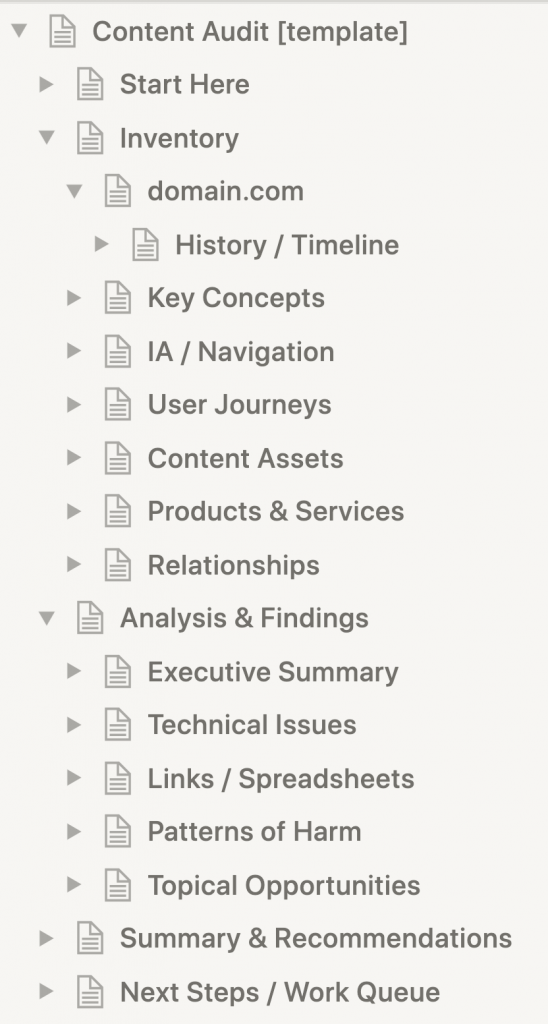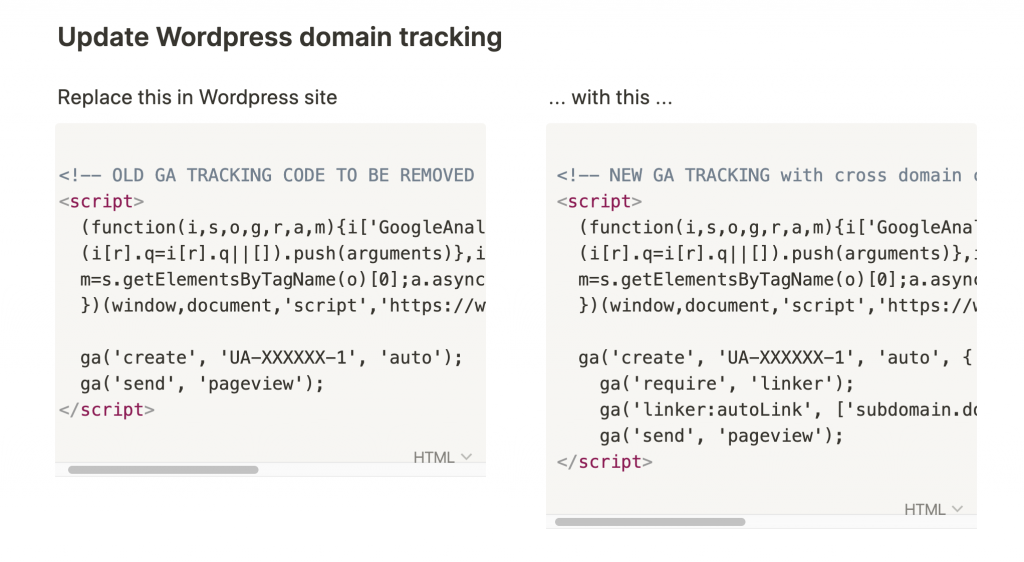I’ve been working through the content audit and related recommendations service I’m launching.
While it’s intended to be completely custom and unstructured, here’s what I am thinking as an optional curriculum for the first few months:
- Month 1 – Planning, data collection, insights engine setup
- Month 2 – Inventory, Tracking, Identifying issues
- Month 3 – On-site improvements, issues, keyword research, one page plan
- Month 4 – freestyle
- Do you have the time, money, willpower to implement recommendations?
- What do you think about options or levels of service?
Month 1 – Planning, data collection, insights engine setup
Lay of the land
For onboarding month, we’ll start by discussing your goals around your content, audience, and offers and map out your rough user journeys in the process and run through high level items here:

(Existing) data collection
The quality of insights depends on relevant data sources getting added to and filled out over time. Data sources include:
- You (situation, goals, content, key ideas, user journeys)
- User data (Google Analytics)
- Search data (Google Search Console)
- Site data (ScreamingFrog)
- Keyword data (SEMRush)
- Link data (Ahrefs)
I either already have subscriptions/licenses or the tools are free. And any key missing data can be filled in with proxies:
- If you don’t have lots of links – we can use link data from competing content.
- If you don’t have lots of existing rankings, we can inform targets and content directions with user journeys and keyword research.
- If you’re missing key analytics tracking, like goals and events setup, enhanced ecommerce, cross-domain tracking, we will set it up.
- If you’re anti-Google Analytics, we can use a fully anonymized analytics platform like Fathom
Insights engine setup
With the ongoing recommendations, data most related to your desired outcomes is continuously compiled, integrated, and enriched for insights.
We don’t know exactly what we’ll end up with in six months or a year, so I’m building flexibility into it. By design we add things as we grow and evolve.
The idea is that the insights engine becomes more customized and powerful, increasing the returns to scale with each passing month.
Month 2 – Inventory, Tracking, Identifying issues
Content inventory
A content inventory is different than an audit. This is where we index what you have in a way that makes it accessible through filters or search.
This process varies depending on amount of content, any existing taxonomies, and time/resources available.
With 50 posts, we would just use a master spreadsheet and spend more time on organizing. With 2,000 posts, we would load all pages but start by focusing on one high level topic cluster of, say, 100 to 200 pages.
Ideal Tracking Setup
Likely this will involve Google Analytics configuration across properties and Google Search Console domain property verification.
Because analytics is so important, I will walk you through every step of proper setup and ensure proper setup of tracking for the needles you care about moving most: search traffic on key articles, email subscriptions, course sales and related actions.
For example, if you don’t have “domain property,” tracking in Google Search Console, I’ll send you the steps. If you need to track Google Analytics across subdomains, I’ll send you exactly what to change for your situation, like this:

Uncovering issues
I’ve spent the past few months developing a more efficient and robust process for surfacing issues that actually matter by priority. You can get a sense of how that works under the hood, but suffice it to say that I will present a punch list of items.
Month 3 – On-site improvements, issues, keyword research, one page plan
Fixing key issues
In month 2, we’ll address any major issues or glaring item we uncovered in the first month. This might be something as simple as fixing how your site is laid out, or more complex, like consolidating pages from multiple domains.
Whatever decisions we come to together, I will provide exact instructions that you can implement yourself or pass off to a developer or virtual assistant.
The point here is to make sure that there is nothing explicit holding back your site’s traffic. If your site is somehow in excellent shape, we will surface a list of underperfoming pages and related patterns for discussion.
Keyword research
This is as practical as keyword research gets. It is the sweet spot between DIY SEO and enterprise SEO. The goal here is to establish a process that:
- you are completely comfortable with
- demystifies the work involved in identifying and comparing opportunities
- results in straightforward steps you are actually going to take
- addresses any bad habits or misconceptions you may have
People can spend 100 hours every quarter prioritizing thousands of keywords by relative cost and value potential. This is not that. What’s most important for you is to identify top 1 to 3 opportunities for:
- existing page improvements
- new page content directions
Again, this is designed for experts. I will never ask you to go off-brand or develop junk filler content around a topic in a generic way.
This is an exercise in surfacing user needs and demand that you are not yet meeting and building a concrete checklist of items to address in existing content for refreshing and new content for scaffolding.
It wouldn’t be unusual for the new page content direction we choose together to end up as your most, if not one of the most, search visible page within a month’s time (this happened with the last two people I went through this exercise with.)
Rank one page
Related to the keyword research, we’re going to walk through real-world optimization for a specific high value page together. This can be:
- For an existing page, this could look like layering in rich snippets, addressing intent that isn’t being satisfied.
- For a new page, this might look like walking through a rough outline or check list together and providing feedback on the resulting article or guide
Month 4 – freestyle
At that point, situational insights and trarget outcome should really drive decisions.
That could look like a focus on information architecture that maps user journeys to relevant content and offers while raising search traffic for hub type pages.
Or it could look like a focus on increasing content quality across the board by iterating through punch lists for refining, consolidating, updating content.
If we’re consolidating a series of similar pages into a guide, we’ll walk through that process of what stays and what on-page navigation for guides.
If you want to prioritize doing a podcast interview circuit to promote a book, then we layer in inbound link profiles and outlinks of your network’s sites to generate a list of top podcasts you could request an email introduction to.
Do you have the time, money, willpower to implement recommendations?
This should be the main questions you ask yourself with any product requiring a commitment from your end. Will you actually apply the insights and what’s that commitment look like?
The rate of insight-based recommendations is intended for a soloist or small team to supplement their current approach given a reasonable amount of attention and bandwidth.
Implementation of insights will take two forms.
Process-based changes (no additional time required)
For one, it’s adjustment to your current processes, meaning the additional time spent for this type of improvement should be nominal. When a golf coach asks you to focus on improving one or two things about your swing, it doesn’t add time.
New item changes (requiring additional work)
The other form is where you need to weigh and consider the additional cost, because it’s doing things you otherwise wouldn’t do.
Provided new change recommendations will include steps that you, a developer resource, or your virtual assistant could carry out.
The additional cost to implement new changes should not exceed 10 hours of work per month. If you don’t personally have the bandwidth for another 10 hours, the cost to implement with a VA or dev should not exceed another $500/month.
Ultimately, you choose what recommendations to implement. If recommendations start to stack up, we’ll take a step back, prioritize the list, and re-establish a plan that works.
It really comes down to what rings true for adapting your business to user needs and the value of anticipated impact.
What do you think about options or levels of service?
Is this too much? Not enough? Too focused on process and not enough on benefits or outcomes? Would it be helpful to share more hands-on what this looks like for clients?
I’m still feeling my way through this service of $500/month for ongoing recommendations and be available by email for any questions. We had some additional thoughts:
Continuous access for questions?
With ongoing recommendations, you can get tailored answers to any questions you might have related to the recommendations being provided.
But what if you have unrelated questions that are related to your target outcomes or decisions that come up.
This could include things like:
- How do you rank in first position for “<your expertise> expert”?
- What about queries like “<your expertise> consultant”
- How do you organize your site to improve traffic and email subscription rates as the same time?
- What pages should you focus on improving given your situation?
- What pages should be deleted, redirected, consolidated?
- When you consolidate content, which page should you keep?
- How do you identify stale content that should be “refreshed”?
- Should you create a new page on your site or buy a new domain for it?
- When trying to decide between two technologies (like Memberspace and Memberpress), which is better for SEO?
- What podcasting solution results in the best search visibility?
You can get an answer anywhere, but you won’t get answers based on deep consideration of your situation and data analysis.
As things inevitably come up, some of you might want access that involves additional analysis.
I could see offer this access for something like an additional $300/month. Should this be an addon?
Recommendations with option for managed implementation
I was talking to Ann (my other half in life and work) about a managed service, where for an additional fee, she would handle the implementation.
Ann is a badass. Just this morning she coordinated a launch for three types of productized services for a client with a large IG following. Setting up email service provider, integrating appointment scheduling with calendar integration, payment processing, Google Analytics, landing page development and offer flows, related support and configurations for changes to product launch on the fly.
You know that kind of stuff can eat up a week or two of your time, easy. And something always goes wrong. But Ann does stuff like this in a few hours with minimal hangups.
If I’m saying the new changes work is $500/month worth of work, would it make sense to offer a done-for-you option where for that amount ($500 + $500), we (Ann) would do the work for you?
This could leave you to focus on process improvement and your core work, but ensure QA at point of implementation. Or it could just complicate the offer. I don’t know.
I would love your feedback here, what do you think?

Articles referencing this one